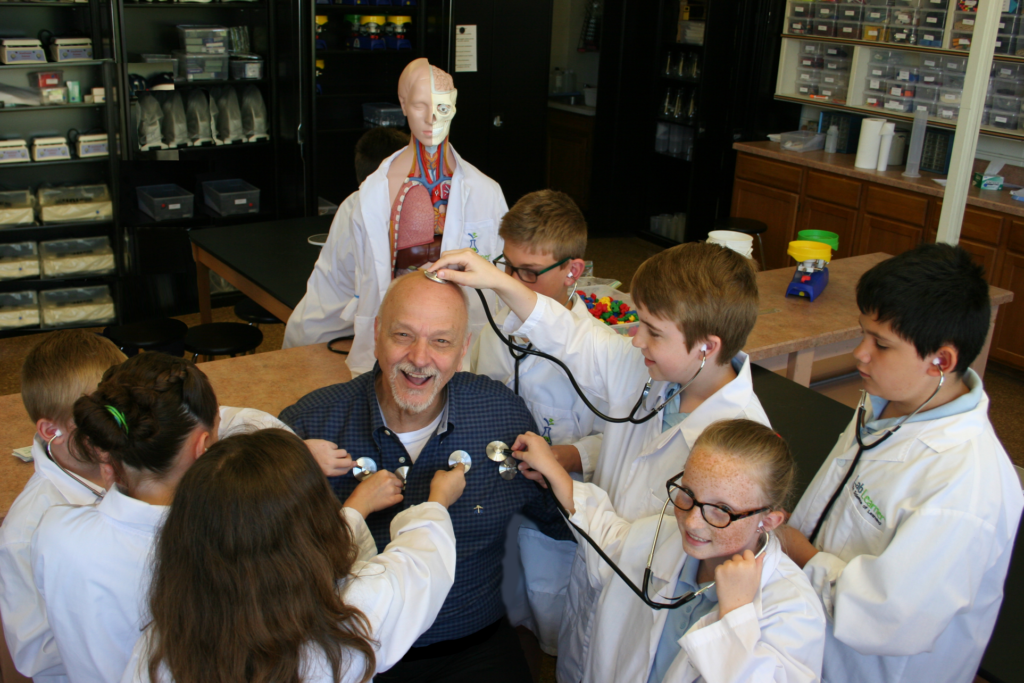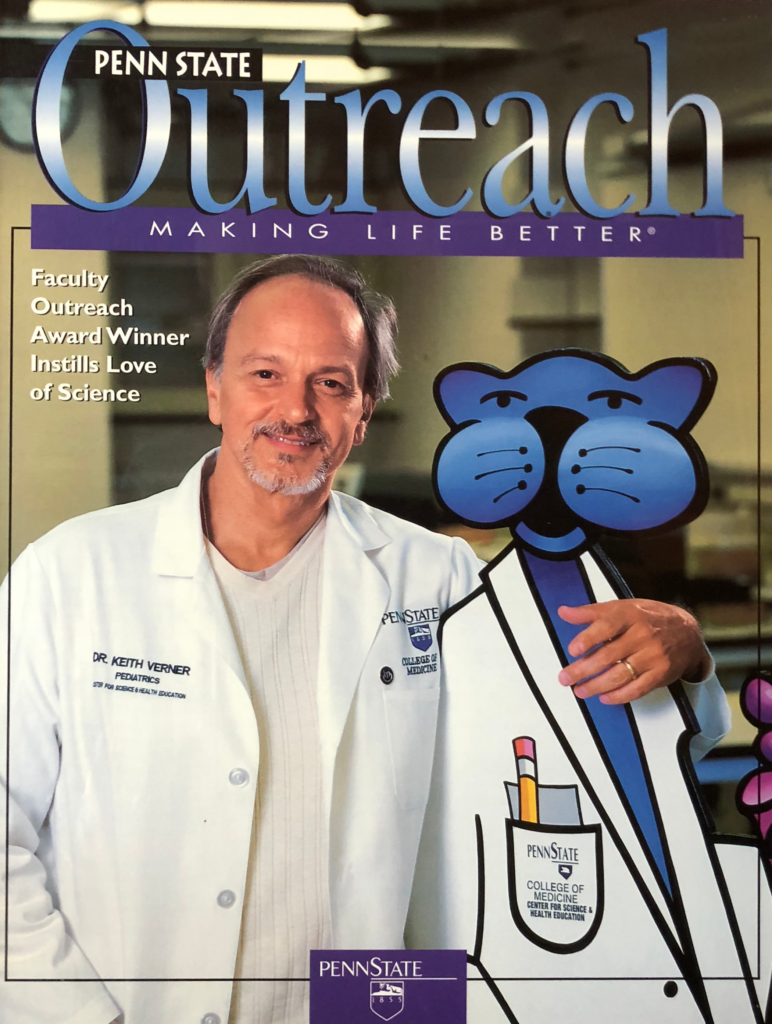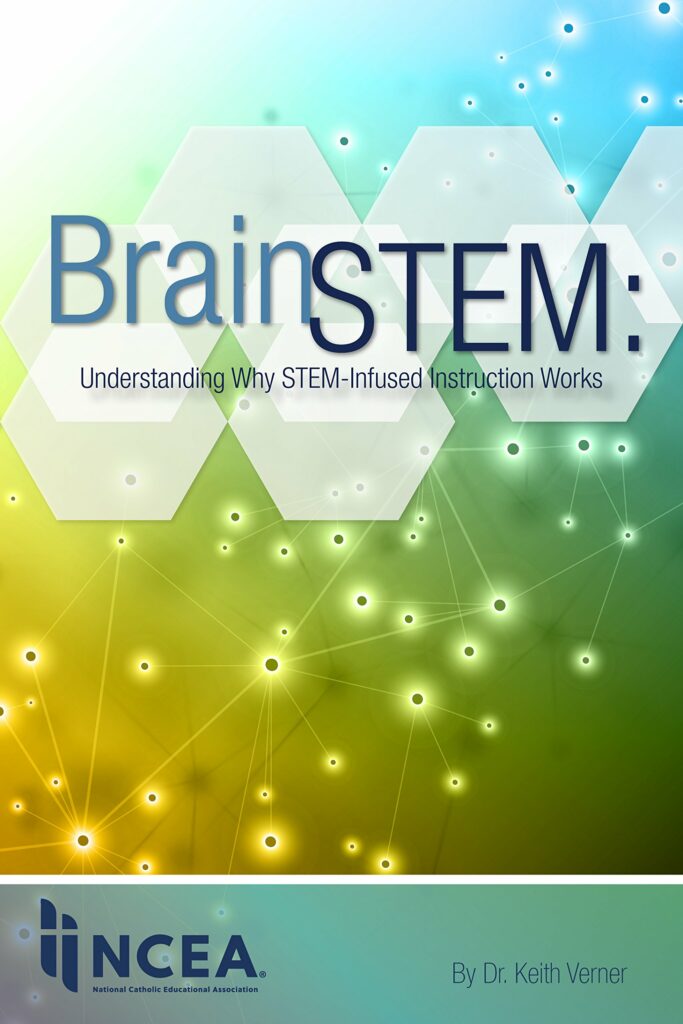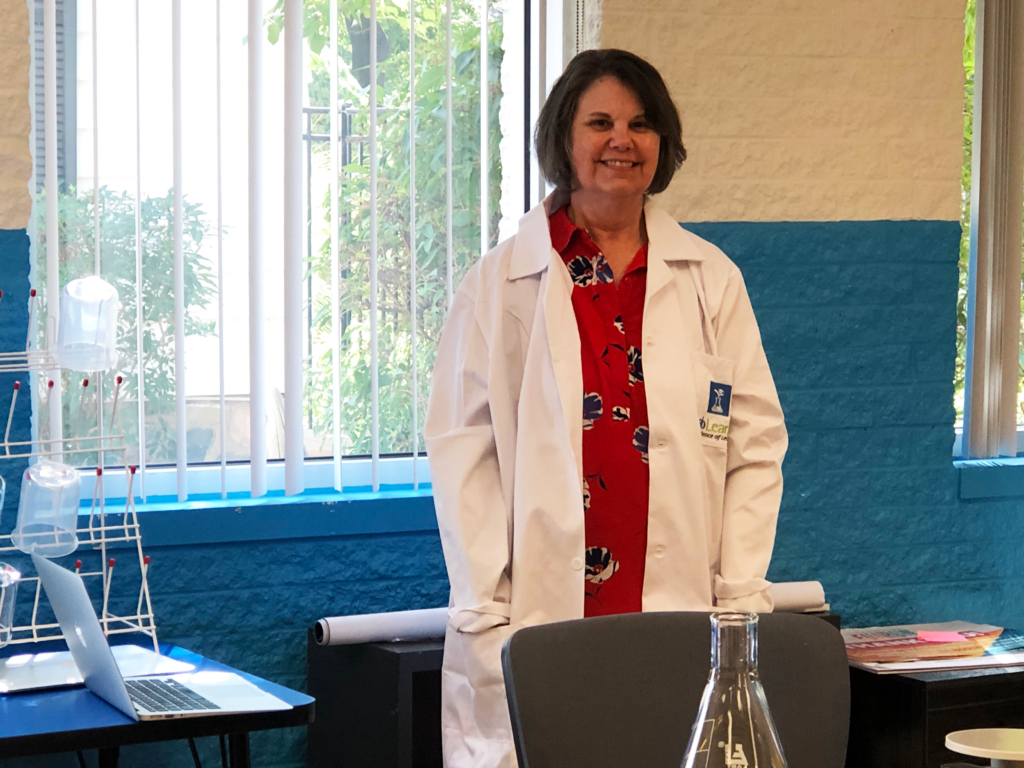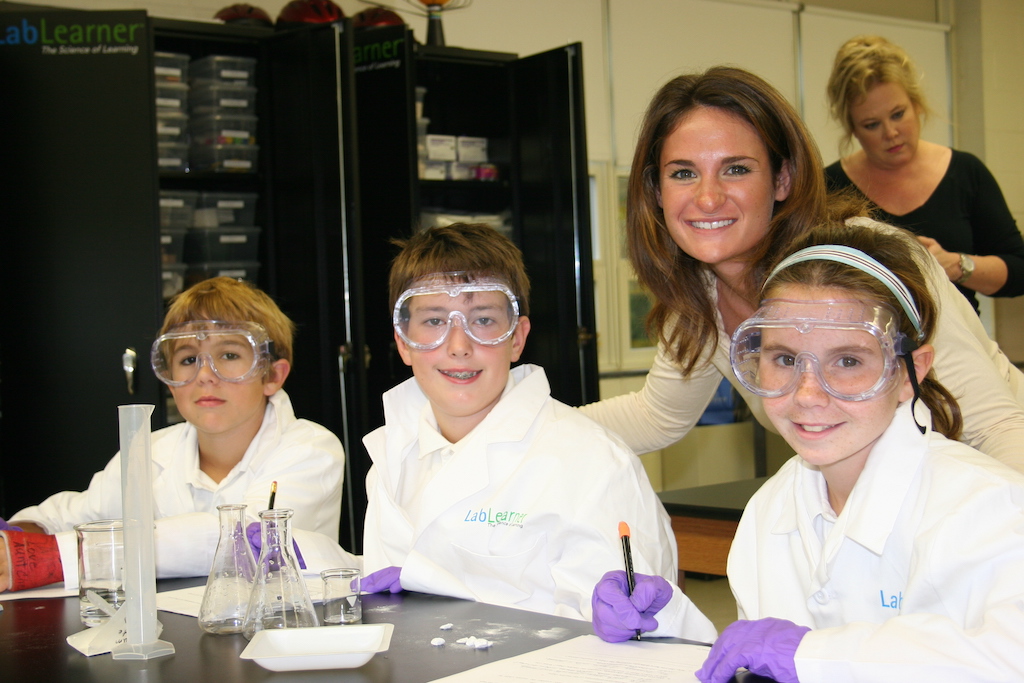LabLearner Science Education
Scientifically Nurturing Future Generations of Innovators and Thought Leaders
Real Laboratory and Science Equipment
In the LabLearner program, students learn science through a series of inquiry-based, hands-on activities that identify and incorporate national science, math, and ELA standards. An integral part of the LabLearner program is the conversion of a school classroom into a fully functional, in-school teaching laboratory appropriate for physical, earth, and life science activities. Additionally, Core Experience Learning Labs (CELLs), written by teams of scientists and classroom teachers, are provided for use by the student and teacher both in the classroom and in the laboratory.
STEM-Based and Spiraling
LabLearner was designed to specifically address science, math, technology, engineering, health and language arts standards, and is a 100% hands-on method of teaching science. The program aims to increase student’s experience with STEM components and to develop students’ cognitive ‘tools’ as they approach science concepts, critical thinking, and problem-solving in a lab environment.
LabLearner integrates various assessments throughout the span of the curriculum from lab-based performance assessments to traditional written assessments. Each assessment is designed to draw upon each student’s experiences within the lab.
Teacher Professional Development: We are With You
A strong component of the LabLearner Program is on-site professional development provided by LabLearner Staff Scientists. Science and math content as well as effective science teaching strategies appropriate for preK-8 students are delivered in hands-on, engaging sessions. In addition, teachers in preK-8 will have full access to a specially designed website (LabLearnerPLUS+) that includes curriculum updates, videos for laboratory equipment and set-up, tips from other teachers for classroom logistics, and additional content related web resources. Teachers can also connect with seasoned LabLearner teachers as a part of a mentoring program, as well as receive free access to LabLearner scientists through e-mail or phone.
Our Founders
Meet Dr. Keith Verner
Dr. Keith Verner received his degree in Biochemistry, Molecular and Cell Biology from Cornell University. He began his research career with a fellowship at the University of Basel Biozentrum in Basel, Switzerland. It is in Basel where Dr. Verner learned first-hand the differences between US and European educational systems by teaching undergraduate students at the University of Basel while his children attended Swiss public schools.
Dr. Verner returned to the US as a faculty member at The Pennsylvania State University College of Medicine. He became Chief of the Division of Developmental Pediatrics and Learning and tenured Professor of Pediatrics and Cellular and Molecular Physiology. He was also appointed Associate Professor of Education in The Pennsylvania State University School of Education and Behavioral Sciences. While at Penn State, he began the BOLD (Biology of Learning and Development) research group, which brought together medical, scientific, and public-school experts to investigate the neurocognitive and neurological underpinnings of both general education and learning disabilities.
As a research scientist and university professor, Dr. Verner published numerous papers, articles, and books. In addition, he received various research and teaching awards and was the recipient of the Penn State University Faculty Outreach Award for his work in public school science education that reached thousands of children. Dr. Verner testified, alongside Senator/astronaut John Glenn, in support of strengthening US pre-college science education before the Senate committee on Health, Education, Labor, & Pensions.
Dr. Verner was publicly elected as a School Director in the Commonwealth of Pennsylvania, serving as either president or vice-president of the Board for three years of his four-year term. He also served as the President of the Board of Delegates at Harrisburg Area Community College during this period.
In 2004 Dr. Verner left his tenured, full-professorship faculty appointment to devote his time to the development and expansion of LabLearner. Since that time, LabLearner has grown from its home in Pennsylvania and is now in use across the country.
Meet Mary Beth Verner
Mary Beth Verner has been with LabLearner since the days it started back in 1996. Mary Beth has worked with her husband, Dr. Keith Verner in either scientific research or science education outreach since she worked as a laboratory technician in the Department of Physiology at Penn State University College of Medicine.
Early on, while Dr. Verner was involved primarily in curriculum development, research, and teaching, Mary Beth laid the foundations for the organizational structure of the entire equipment and supplies side of what would become LabLearner. From the beginning it was an awesome undertaking. Purchasing equipment and supplies that met exactly the scientific and curricular specifications involved fostering relations with many different vendors. In addition, coordinating the shipping and receiving of thousands of laboratory items to dozens of schools across the country required many clever solutions. Without solving such problems, it is unlikely that LabLearner would exist today.
Mary Beth and Dr. Verner remain on the frontline of cutting-edge science and STEM education with no intention of slowing down as they both love the work and share the mission. Mary Beth was Catholic school educated at Our Lady of Sorrows Catholic School in Farmington, Michigan before attending Oakland University.
LabLearner Educators
LabLearner Master Teacher Consultants Across the Country
LabLearner works with principals and teachers across the country. Our consultants are chosen from among the best teachers anywhere. All LabLearner developments and upgrades are crafted in collaboration with and tested by our master teachers in real classrooms, and this research and development continues on an ongoing basis.
LabLearner teacher consultants work in schools from every demographic imaginable, from the inner city to rural farmlands. For example, we are currently in our second year of beta-testing our new LabLearner middle school program, which integrates state-of-the-art wireless Bluetooth scientific probes, such as spectrophotometers, dissolved oxygen sensors, pH and temperature probes, and much more, into the basic LabLearner curriculum. With excellent results thus far, we will offer this upgrade to our LabLearner schools nationwide for the 2025/26 school year. This new system will launch our middle school students into the digital acquisition and analysis of their laboratory findings and prepare them for the future. Our Beta-test schools for just this project are shown to the right.
LabLearner Facts & Figures
STEM and STEM education are widely recognized topics of interest for educators, parents, business, and governments globally. This is because success in STEM (science, technology, engineering, and mathematics) is directly associated with other forms of success at many levels. STEM drives economies upward. On an international level, STEM success is a common ingredient of strong and highly competitive nations. Consequently, most adults are interested in STEM and STEM education for one good reason or another – perhaps parents of schoolchildren most of all.
Out of 100 STEM occupations, 93% of them had salaries well above the national average. The average for STEM career annual salaries is $87,570, whereas the average for non-STEM jobs is roughly half that ($45,700) 1, 2. Add to this, projections indicating substantial future growth in STEM jobs (13% increase in STEM jobs between 2017 and 2027, compared to 9% for nonSTEM jobs)1, 3. Since 1990, employment in STEM fields has grown nationally by 79 percent, from 9.7 to 17.3 million4.
While we may care about STEM, how are our students actually doing in STEM subjects compared to their peers globally? Not very well. U.S. students placed 38th of seventy-one countries in mathematics, and only 24th in science on the Program for International Student Assessment (PISA) exam5.
Although 48% of the 2.1 million 2016 high school graduates who took the ACT exam stated an interest in STEM majors and careers, only a quarter of the students who took the test (26 %) met or surpassed the ACT College Readiness Benchmark in STEM6, 7. That is, most test-takers were not prepared in the U.S. PreK-12 education system to pursue university science courses without difficulty and/or remediation.
Taken together, the facts related to the importance of STEM and the current state of STEM education in the U.S., must compel us to seriously focus on improving our approach to precollege STEM education.
LabLearner science and STEM education programs are dedicated to improving precollege STEM education across the U.S., as well as instilling an understanding and love of STEM for all students. LabLearner is a PreK-8, 100% hands-on science education system designed both for students that eventually go into one of the many STEM careers, as well as students that choose other career directions. LabLearner programs are committed to increasing critical thinking and problem-solving skills of all students and increasing the excitement and joy of understanding STEM throughout their lives.
____________________________
REFERENCES
1. Ryan. The State of STEM Education Told Through 12 Stats. iD Tech Blogs & News. November 2019. https://www.idtech.com/blog/stemeducation-statistics
2. Fayer, S., Lacey, and Watson, A. STEM Occupations: Past Present, and Future. U.S. Bureau of Labor Statistics, January 2017. https://www.bls.gov/spotlight/2017/science-technology-engineering-andmathematics-stem-occupations- past-present-and future/pdf/science-technology-engineering-and-mathematics-stem-occupations-past-present-and future.pdf
3. Economic Modeling Specialists International, April 2017.
4. Graf, N., Fry, R., and Funk, C. Facts About the STEM Workforce. Factank News in the Numbers, Pew Research Review, January 2018. https://www.pewresearch.org/fact-tank/2018/01/09/7-facts-about-the-stemworkforce/
5. Desilver, D. U.S. Students’ Academic Achievement Still Lags Behind That of Their Peers in Many Other Countries. Factank News in the Numbers, Pew Research Review, February 2017. https://www.pewresearch.org/facttank/2017/02/15/u-s-students -internationally-math-science/
6. Change, R. Report: Many High School Graduates Want to Pursue STEM Careers but are Unprepared for STEM College Courses. THE Journal, November 2016.
7. STEM Education in the U.S. Where We Are and What We Can Do/2017. ACT Research, 2017. http://www.act.org/content/dam/act/unsecured/documents/STEM/2017/STEM-Education-in-the-US-2017.pdf
As discussed above, the LabLearner program of science education has been in use for well over a decade across the U.S. with outstanding results and sustainability. This is largely because of the way in which the program was developed and scientifically tested. The entire LabLearner approach to curriculum, assessment, and teacher training began in the 1990s by teams of scientists from a wide range of basic science domains, as well as neurocognitive scientists, physicians, neuroimaging radiologists, educational psychologists, practicing public and private school PreK-12 educators, and educational administrators.
Given the profile of LabLearner developers, it is not surprising that the basis of the program is firmly grounded in the neurocognitive and 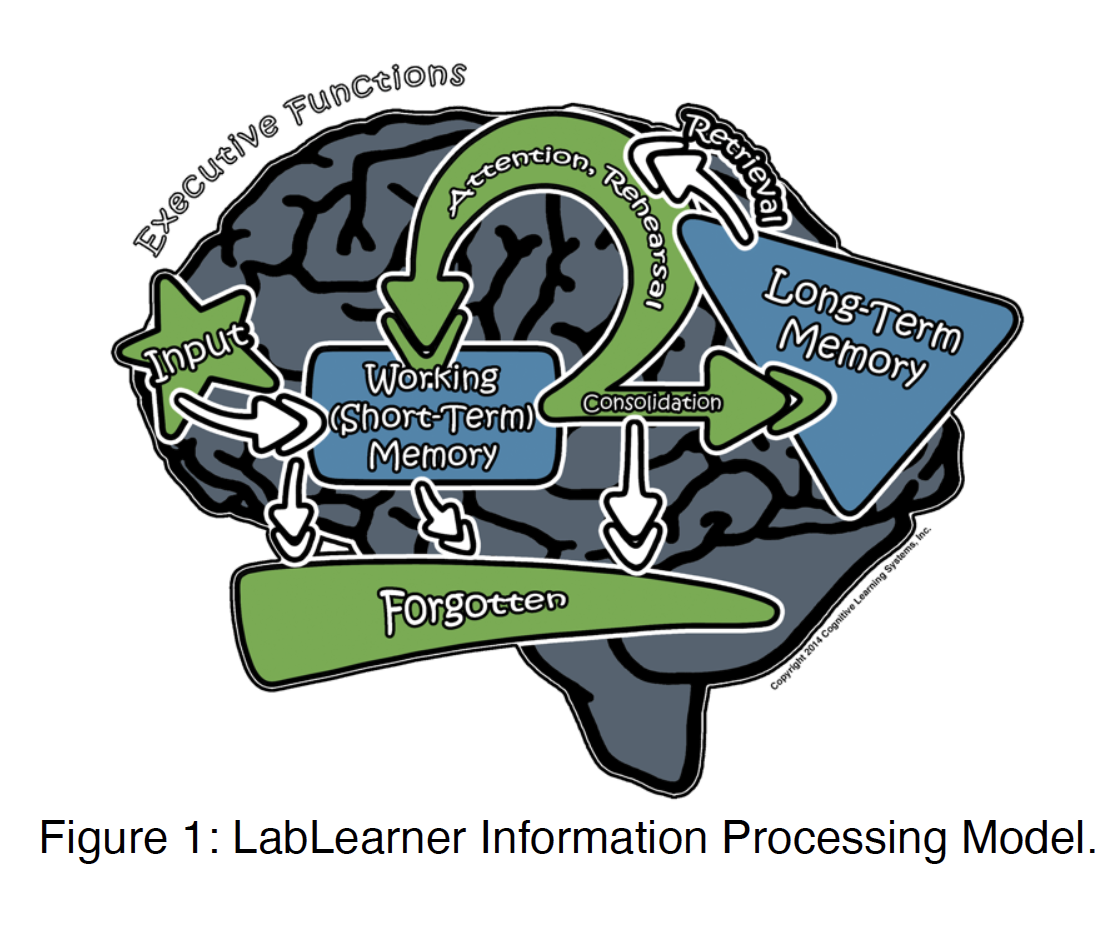 biomedical sciences. However, the key to LabLearner’s “usability” and success in schools across the country is largely due to the inclusion of practicing educators in the development process. PreK-12 educators brought and continue to bring practical classroom intelligence to LabLearner curriculum design, day-to-day instruction, and meaningful student assessment.
biomedical sciences. However, the key to LabLearner’s “usability” and success in schools across the country is largely due to the inclusion of practicing educators in the development process. PreK-12 educators brought and continue to bring practical classroom intelligence to LabLearner curriculum design, day-to-day instruction, and meaningful student assessment.
As a result of preliminary research, LabLearner developed its own version of what is known as the information processing model as the basis and guide for curriculum and program development. The LabLearner Information Processing Model8 is shown in Figure 1. Without being able to go into detail here, it must suffice to say that each of the many steps and interactions between brain functions depicted in the model have been recognized and exploited by 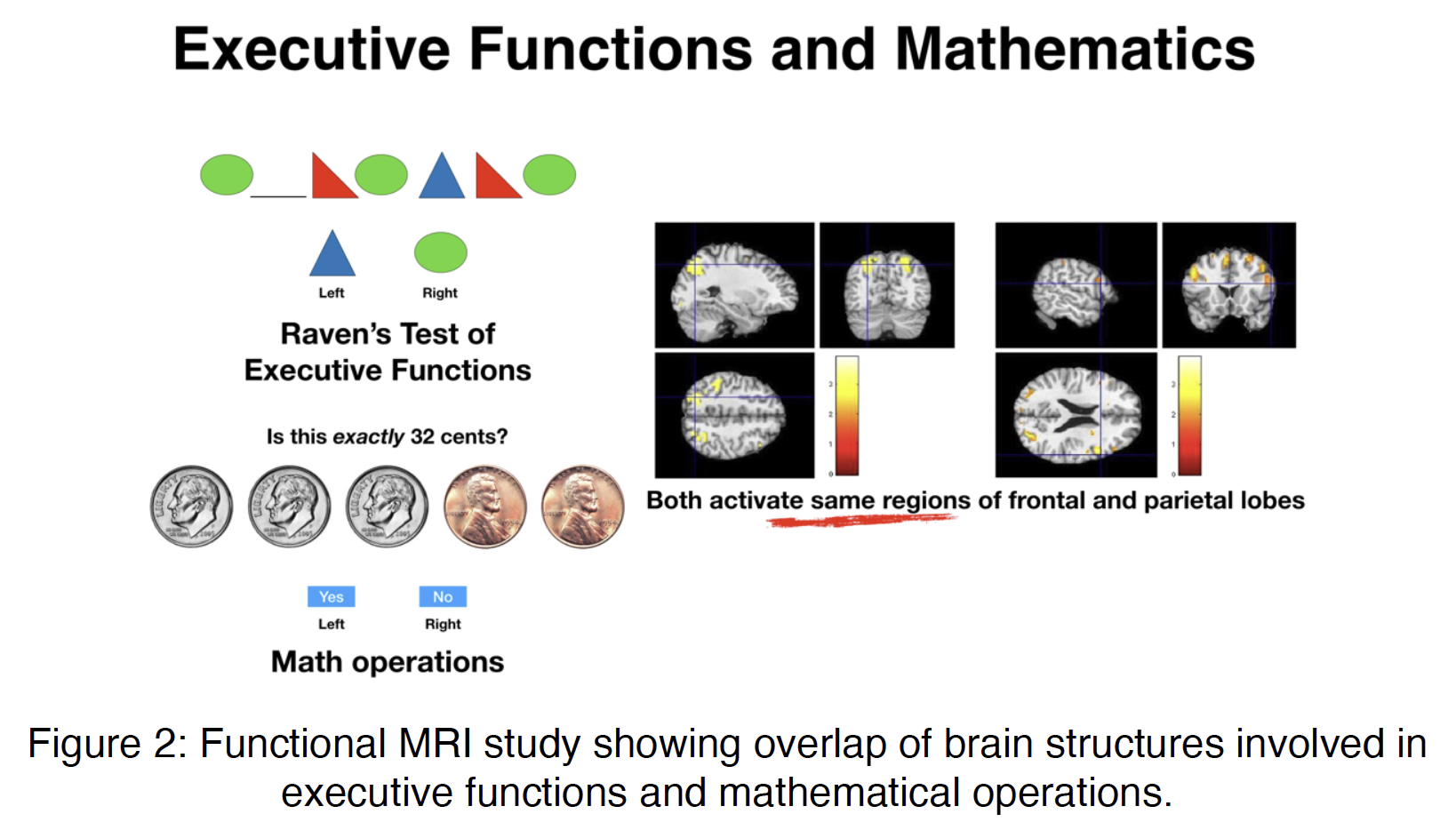 LabLearner developers for maximum cognitive impact on students in curriculum development as well as in teacher professional development.
LabLearner developers for maximum cognitive impact on students in curriculum development as well as in teacher professional development.
Functional Magnetic Resonance Imaging (fMRI) studies are providing important and fascinating insight into understanding the important neurocognitive processes involved in human learning and memory depicted in the information processing model. For example, Figure 2 highlights research results that point to the exquisite relationship of executive functions and mathematical operations9, while Figure 3 depicts the distinctive patterns of neural activation between mathematical operations and language processing10.
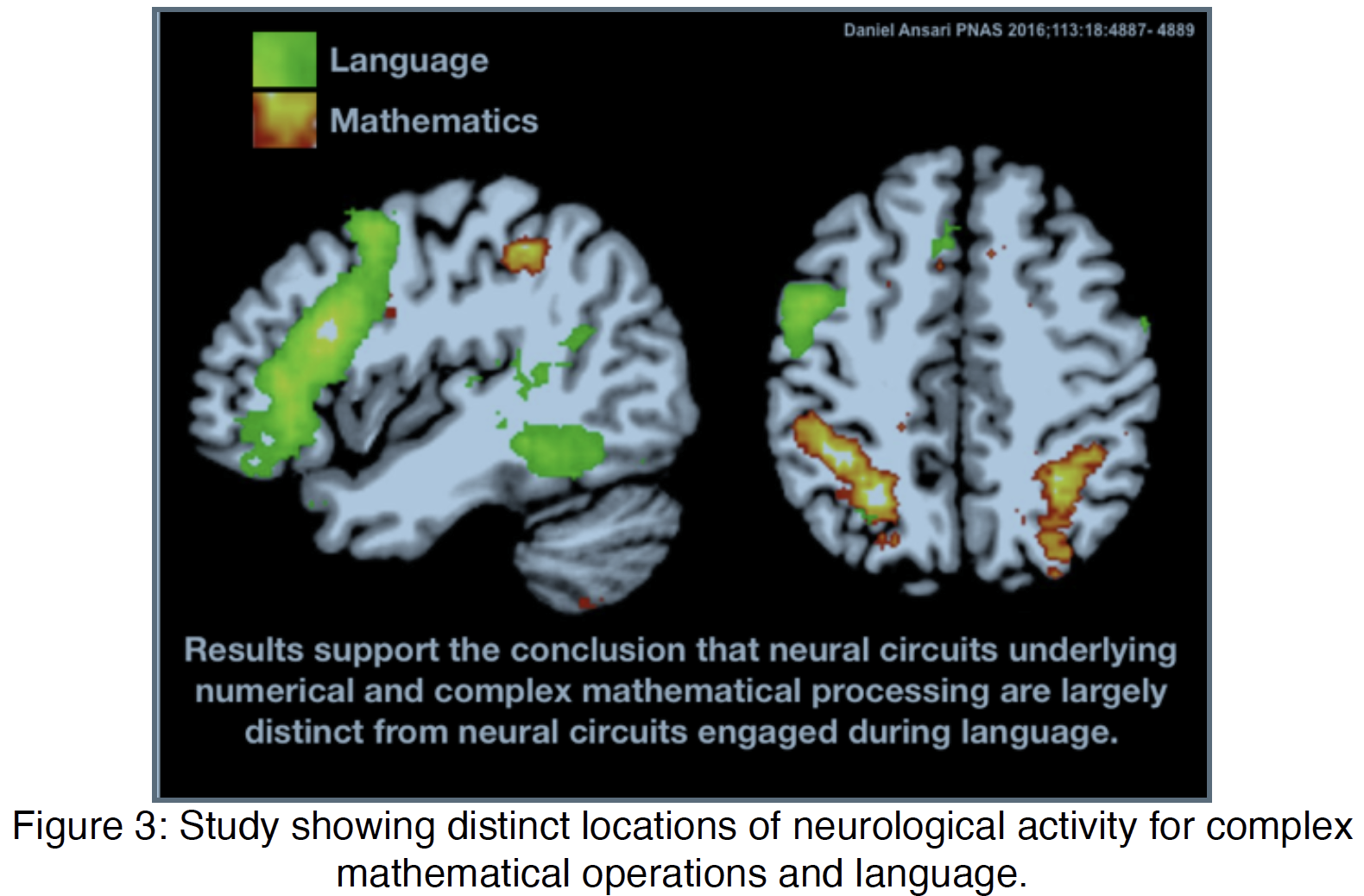
LabLearner personnel continue to follow this line of scientific research at The Pennsylvania State University College of Medicine Magnetic Resonance Imaging Core Facility. We are particularly interested in work dealing with the interaction between the executive neural network and the default mode network in creativity and scientific thinking and discovery11, 12. We are also focusing on the relationship between executive functions (EF) and critical thinking (CT) as a means of actively promoting and teaching students critical thinking skills through STEM education13. To understand the relationship between CT and EF, we must explore how EF orchestrates the functioning of information processing in the brain and exactly how information processing leads to learning and memory. We must also strive to understand how both teachers and the curriculum itself, if designed in a spiraling manner, can help in the 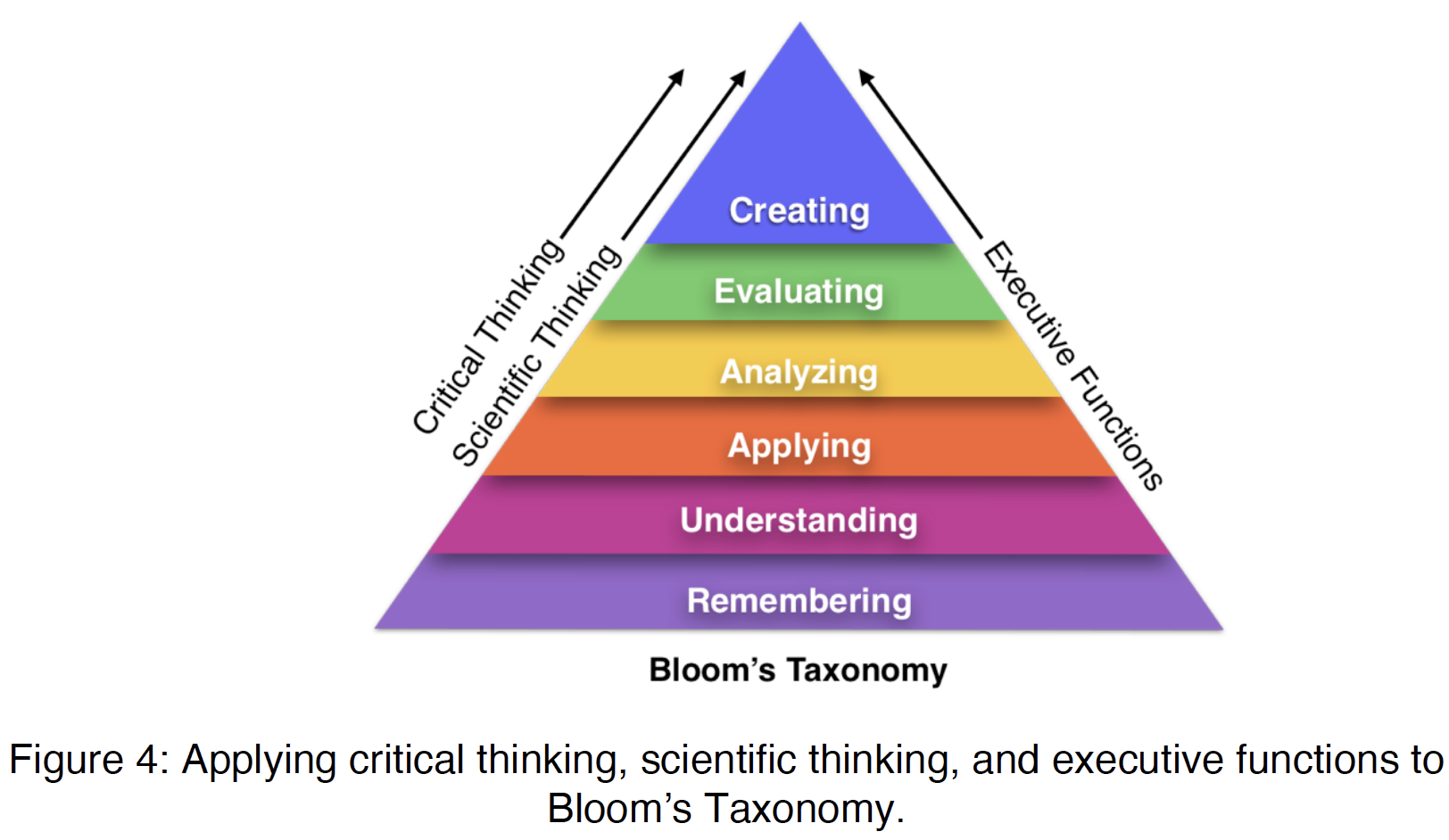 development of EF and CT in the classroom. A visual summary of this concept in relation to Bloom’s Taxonomy (a concept understood by all practicing educators) is shown in Figure 4.
development of EF and CT in the classroom. A visual summary of this concept in relation to Bloom’s Taxonomy (a concept understood by all practicing educators) is shown in Figure 4.
The early phases of LabLearner development and testing involved both public and private universities with funding from the National Science Foundation, The Howard Hughes Medical Institute and the Pennsylvania Department of Education. The strength of the LabLearner reputation led Chairman Senator Edward Kennedy to call upon Dr. Keith Verner, LabLearner’s founder, to testify before the U.S. Senate Committee on Health, Education, Labor and Pensions, along with Senator John Glenn and Dr. Rita Caldwell, then Director of the National Science Foundation, at its hearing on NSF reauthorization14. Dr. Verner’s testimony was devoted to the important impact of PreK-12 science education on the development of a strong American STEM system of education – one that would permit American students to compete internationally.
In summary, LabLearner has devoted nearly twenty years of development and testing to produce and constantly refine its state-of-the-art science education program.
_____________________________
REFERENCES
8. Verner, K. BrainSTEM: Understanding Why STEM-Infused Instruction Works. ASIN: B07GH45VQC. NCEA Press (2018).
9. Baker, D., Eslinger, P. et al. The Cognitive Impact of the Education Revolution: A Possible Cause of the Flynn Effect on Population IQ. Intelligence 49, March-April (2015).
10. Ansari, D. The Neural Roots of Mathematical Expertise. PNAS, May (2016). https://www.pnas.org/content/early/2016/04/18/1604758113
11. Kounios, J and Beeman, M. The Aha! Moment: The Cognitive Neuroscience of Insight. Current Directions in Psychological Science,18:4 (2016).
12. Luo, J. and Niki, K. Function of Hippocampus in “Insight” of Problem Solving. Hippocampus, 13 (2003).
13. Verner, K. Assessing Critical Thinking: Preparing the Next Generation of Creative and Effective Problem Solvers. NCEA Talk, May (2018). https://nceatalk.org/2018/05/assessing-critical-thinking-preparing-the-next-generation-of-creative-and-effective-problem-solvers/
14. Reauthorization of the National Science Foundation: Strengthening Math and Science Education Research and Development. The Senate of the United States. (2002). https://www.govinfo.gov/content/pkg/CHRG-107shrg80421/html/CHRG-107shrg80421.htm
The LabLearner science education program is now used in hundreds of schools across the U.S. The first LabLearner installations and teacher professional developments began in 2004. Thus, LabLearner has been functioning as the primary science education curriculum for PreK-8 students for well over a decade. During this period, tens of thousands of students have benefitted from LabLearner’s rigorous, hands-on approach to science instruction and science skill development.
Geographically, LabLearner schools are scattered across the United States and are located in a majority of States. In addition to wide geographic distribution, LabLearner schools represent a wide and diverse variety of educational systems and demographic student populations. LabLearner schools are located in heavily populated urban centers. For example, LabLearner currently has 43 schools in Brooklyn/Queens and 28 schools in Philadelphia. On the other hand, LabLearner serves schools in some of the most remote and sparsely populated districts in the country, some with district high school graduation classes of a dozen or less.
LabLearner has been very popular and successful in private schools, public schools and public charter schools. Among non-public institutions, Catholic schools have strongly embraced LabLearner across the country. It is also the curriculum choice for other outstanding types of non-public and public schools. Since the early 2000’s until present, LabLearner has been the science education program of choice in schools across the country.
LabLearner schools are highly sustainable and they have remarkable program loyalty and retention rates. Ongoing annual costs for the LabLearner program are minimal and mainly include student lab books and minor materials replenishment. Minimal maintenance costs were designed into the LabLearner program from its inception.
Sustainable annual costs and comprehensive customer service are two of the many reasons LabLearner enjoys long-lasting relationships with its schools. Of the hundreds of LabLearner schools installed over the past 16 years, only a small handful have discontinued the program! Therefore, a striking majority of schools have stuck with LabLearner through many cycles of curriculum review. Consequently, not only has LabLearner delivered on its promise of the highest quality hands-on science instruction available, the system leads to a highly stable science and STEM curriculum. Many tens of thousands of students have taken LabLearner education benefits into high school science and into their college education and careers.
STEM stands for Science, Technology, Engineering, and Mathematics. Since the introduction of this acronym, however, other academic domains have been added to the STEM base. Thus, STEAM adds Art to the mix, while STREAM adds Reading and/or Religion.
LabLearner, together with a complementary mathematics curriculum, can easily serve as a firm base from which to build strong STEM, STEAM, and STREAM programs. A solid grounding in science and mathematics provides the theoretical and analytical framework that provides structure and logic to all approaches to enhancing critical thinking, innovative thinking, and cognitive processing skills.
Our Founder
Meet Dr. Keith Verner, Founder of LabLearner
Dr. Keith Verner received his degree in Biochemistry, Molecular and Cell Biology from Cornell University. He began his research career with a fellowship at the University of Basel Biozentrum in Basel, Switzerland. It is in Basel where Dr. Verner learned first-hand the differences between US and European educational systems by teaching undergraduate students at the University of Basel while his children attended Swiss public schools.
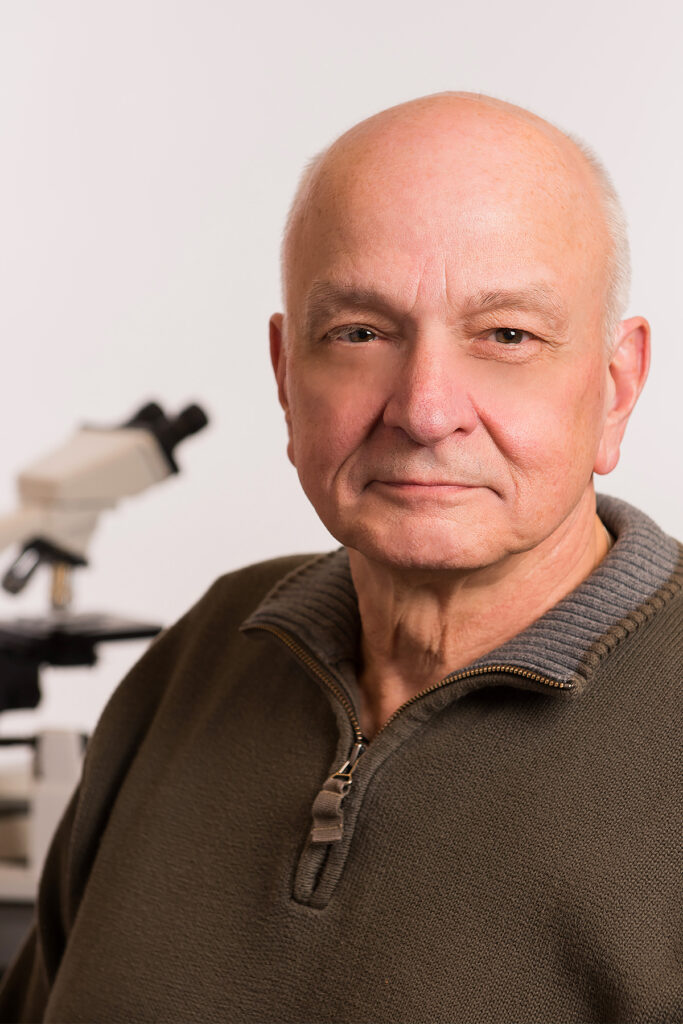
Dr. Verner returned to the US as a faculty member at The Pennsylvania State University College of Medicine. He became Chief of the Division of Developmental Pediatrics and Learning and tenured Professor of Pediatrics and Cellular and Molecular Physiology. He was also appointed Associate Professor of Education in The Pennsylvania State University School of Education and Behavioral Sciences. While at Penn State, he began the BOLD (Biology of Learning and Development) research group, which brought together medical, scientific, and public-school experts to investigate the neurocognitive and neurological underpinnings of both general education and learning disabilities.
As a research scientist and university professor, Dr. Verner published numerous papers, articles, and books. In addition, he received various research and teaching awards and was the recipient of the Penn State University Faculty Outreach Award for his work in public school science education that reached thousands of children. Dr. Verner testified, alongside Senator/astronaut John Glenn, in support of strengthening US pre-college science education before the Senate committee on Health, Education, Labor, & Pensions.
Dr. Verner was publicly elected as a School Director in the Commonwealth of Pennsylvania, serving as either president or vice-president of the Board for three years of his four-year term. He also served as the President of the Board of Delegates at Harrisburg Area Community College during this period.
In 2004 Dr. Verner left his tenured, full-professorship faculty appointment to devote his time to the development and expansion of LabLearner. Since that time, LabLearner has grown from its home in Pennsylvania and is now in use across the country.

